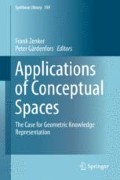Abstract
This paper explores how a conceptual space for the representation of word meanings can be constructed and visualized for one particular domain, namely Dutch words for different types of shirts. It draws on earlier empirical corpus-based research that has identified different features for uniquely describing each of these types and different ways in which they are lexically described in fashion magazines. The present study defines a metric that makes it possible to construct a feature-based space in which the extension of each of the Dutch shirt terms can be visualized and in which it is possible to study the distribution of words and the validity of different constraints on that distribution: conjunctivity, convexity, connectivity, coherence, and centrality. Although the paper concludes that definite conclusions about these constraints are only possible on the basis of more complete lexical datasets, it demonstrates the potential of the conceptual space approach for studying word meanings.
Part of this paper was presented at the workshop Conceptual Spaces at Work, Lund, May 24–26, 2012.
Access this chapter
Tax calculation will be finalised at checkout
Purchases are for personal use only
Notes
- 1.
Note that the term ‘meaning’ is used here in a very broad sense, encompassing both specific referents and general functions, and both non-theoretical and theoretical notions of meaning.
- 2.
A referent like [52131] is a type of object that corresponds to many different tokens that share these five properties, but differ in a lot of other properties.
- 3.
The book actually gives 246 configurations, but there are two pairs with the same feature profile, so I counted both of these pairs as one referent. Therefore the configurations numbered 67 and 68 are missing in my list.
- 4.
For more sophisticated similarity measures based on features see Tversky (1977).
- 5.
The graph is drawn by the graphviz software package, using the neato command, which creates a layout that approximates distances in the graph.
- 6.
Notice that graphviz does not draw the same graph with a fixed orientation, which is why the graph in Fig. 4.5 is rotated.
- 7.
There is no system in the list, apart from the fact that sometimes a contiguous range of items in the list seem to belong to the same category.
References
Gärdenfors, P. (2000). Conceptual space: The geometry of thought. Cambridge, MA: The MIT Press.
Gärdenfors, P., Warglien, M., & Westera, M. (2012). Event structure, conceptual spaces, and the semantics of verbs. Theoretical Linguistics, 38(3–4), 159–193.
Geeraerts, D., Grondelaers, S., & Bakema, P. (1994). The structure of lexical variation: Meaning, naming, and context. Berlin/New York: Mouton de Gruyter.
Geuder, W., & Weisgerber, M. (2002). Verbs in conceptual space. In G. Kath, S. Reinhard, & P. Reuter (Eds.), Sinn & Bedeutung VI proceedings of the sixth annual meeting of the Gesellschaft für Semantik (pp. 69–83). Osnabrück, Germany: University of Osnabrück.
Grimm, S. (2011). Semantics of case. Morphology, 21, 515–544.
Hage, P. (1997). Unthinkable categories and the fundamental laws of kinship. American Ethnologist, 24(3), 652–667.
Haspelmath, M. (1997). Indefinite pronouns (Oxford studies in typology and linguistic theory). Oxford: Oxford University Press.
Haspelmath, M. (2003). The geometry of grammatical meaning: Semantic maps and cross-linguistic comparison. In M. Tomasello (Ed.), The new psychology of language (Vol. 2, pp. 211–242). Mahwah: Lawrence Erlbaum.
Kay, P., Berlin, B., Maffi, L., Merrifield, W. R., & Cook, R. (2009). The world color survey. Stanford: Center for the Study of Language and Information.
Levinson, S. C., & Meira, S. (2003). ‘Natural concepts’ in the spatial topological domain – Adpositional meanings in crosslinguistic perspective: An exercise in semantic typology. Language, 79(3), 485–516.
Majid, A., Boster, J. S., & Bowerman, M. (2008). The cross-linguistic categorization of everyday events: A study of cutting and breaking. Cognition, 109(2), 235–250.
Malt, B. C., Sloman, S. A., Gennari, S., Meiyi Shi, & Yuan Wang. (1999). Knowing versus naming: Similarity and the linguistic categorization of artifacts. Journal of Memory and Language, 40, 230–262.
Malt, B. C., Gennari, S., & Imai, M. (2010). Lexicalization patterns and the world-to-words mapping. In B. C. Malt & P. Wolff (Eds.), Words and the mind: How words encode human experience (pp. 29–57). Oxford: Oxford University Press.
Regier, T., Kay, P., & Khetarpal, N. (2009). Color naming and the shape of color space. Language, 85, 884–892.
Rosch, E., & Mervis, C. B. (1975). Family resemblances: Studies in the internal structure of categories. Cognitive Psychology, 7, 573–605.
Tversky, A. (1977). Features of similarity. Psychological Review, 84(4), 327–352.
Van der Auwera, J., & Plungian, V. (1998). Modality’s semantic map. Linguistic Typology, 2, 79–124.
Zwarts, J. (2010). Semantic map geometry: Two approaches. Linguistic Discovery, 8(1), 377–395.
Acknowledgements
I thank the audience for helpful questions and remarks as well as two anonymous reviewers and Peter Gärdenfors for their comments. The Netherlands Organization for Scientific Research (NWO, grant 360-70-340) and the Swedish Collegium for Advanced Study are also gratefully acknowledged for their support.
Author information
Authors and Affiliations
Corresponding author
Editor information
Editors and Affiliations
Rights and permissions
Copyright information
© 2015 Springer International Publishing Switzerland
About this chapter
Cite this chapter
Zwarts, J. (2015). Conceptual Spaces, Features, and Word Meanings: The Case of Dutch Shirts. In: Zenker, F., Gärdenfors, P. (eds) Applications of Conceptual Spaces. Synthese Library, vol 359. Springer, Cham. https://doi.org/10.1007/978-3-319-15021-5_4
Download citation
DOI: https://doi.org/10.1007/978-3-319-15021-5_4
Publisher Name: Springer, Cham
Print ISBN: 978-3-319-15020-8
Online ISBN: 978-3-319-15021-5
eBook Packages: Humanities, Social Sciences and LawPhilosophy and Religion (R0)

